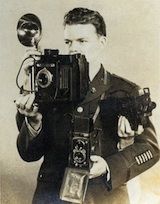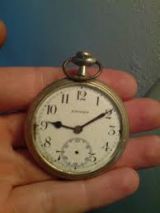- Forum
- General Discussion | Introductions | Off Topic Forum
- Photography General Discussion
- Calculating long exposure times
Calculating long exposure times
-
 Topic Author
Topic Author
- Janos
- Snapobsessed
-
- Nikon D800 and D80
- Followers: 97
- Posts: 443
-
Points:
2230
Post #149321
-

- Shadowfixer1
- Photo Elder
-
- Olympus OMD E-M1 MKII
- Followers: 1350
- Posts: 5560
-
Points:
73865
Post #149325
-

- Henry Peach
- Apprentice
-
- I currently use a 5DII or Sony Nex-3 most of the time.
- Followers: 50
- Posts: 2925
-
Points:
16
Post #149326
If you are looking to use the in-camera meter you can set it at the max aperture and max ISO, meter, and then calculate the stops difference between the ISO and aperture you plan to use. Set the aperture and ISO where you want them, and add all the stops to the exposure time. With digital each doubling of the exposure time is 1 stop. With film you would need to consult the manufacturer's info on reciprocity failure, and probably do some personal testing.
-
 Topic Author
Topic Author
- Janos
- Snapobsessed
-
- Nikon D800 and D80
- Followers: 97
- Posts: 443
-
Points:
2230
Post #149337
Or with the camera's meter when you say max ISO are you talking about aperture is wide open at let's say 2.8, shutter is set to 30 seconds and I use my ISO setting to set exposure. Where the ISO lands that would be considered the max?
Any chance can would either of you have some figures to use as example?
I really appreciate your help on these questions!
-

- effron
- Newbie
- Followers: 1623
-
Points:
129640
-

- MLKstudios
- Banned
-
- D800 ;-)
- Followers: 72
- Posts: 4480
-
Points:
2
Post #149357
HTH
f/8 and be there!!
Matthew L Kees
MLK Studios Photography School
www.MLKstudios.com
[email protected]
"Every artist, was once an amateur"
-

- Henry Peach
- Apprentice
-
- I currently use a 5DII or Sony Nex-3 most of the time.
- Followers: 50
- Posts: 2925
-
Points:
16
Post #149359
Janos wrote: Or with the camera's meter when you say max ISO are you talking about aperture is wide open at let's say 2.8, shutter is set to 30 seconds and I use my ISO setting to set exposure. Where the ISO lands that would be considered the max?
If your meter suggests 30 sec @ f/2.8 @ ISO 3200 that's the same exposure as 8 hours 32 min @ f/22 @ ISO 100. 6 stops between f/2.8 and f/22. 5 stops between ISO 3200 and ISO 100. 11 stops total. Start with 30 sec and double 11 times, and if my math is correct it's 8 hours and 32 min.
I do some night photography, but not star trails. As the Earth rotates at the same speed for everyone you should be able to find example photos of particular exposure lengths.
I'm usually trying to reduce exposure time which may not be a good idea for star trails. I use ISO 100, and then set my aperture as large as it will go to get what I want in my scene in focus. If there is nothing in the foreground close to the camera I may be able to use fairly large apertures. Look into hyperfocal distance if you aren't familiar.
EDIT: Whoops, I think 30 sec to 8 hrs 32 min is only 10 stops. Double it again for 11 stops.
Post #149374
-

- Shadowfixer1
- Photo Elder
-
- Olympus OMD E-M1 MKII
- Followers: 1350
- Posts: 5560
-
Points:
73865
Post #149388
Good info in these.effron wrote: stevencastle.wordpress.com/2007/11/18/long-exposure-theory/
www.fredparker.com/ultexp1.htm
A quick example. Let's assume an ISO of 100 is adequate to get a reading. If the lens you are using has it's widest aperture at lets say f-4.0 and you get a shutter reading of 15 seconds. Now you say you really want to shoot at f-22.0. Lets step it up from our known exposure. f-5.6 would take 1 30 seconds, f-8.0 would take 1 minute, f-11.0 would take 2 minutes, f-16.0 would take 4 minutes and finally f-22.0 would take 8 minutes.
Now if you can't get a reading at the above ISO 100 but you can at ISO 200, when you go back to ISO 100, just double the time. Lets say at ISO 200 you get 30 sec at f-4.0 which means it would be out of your meter range at ISO 100. To go from the ISO 200, 30 sec. at f-4.0 back to a ISO of 100, that setting would be ISO 100, F-4.0 for 1 minute. The you just go from there to get the shutter for f-22.0. It's real simple math once you understand the theory of stops. I may not be clear with my explanations, but I hope this helps.
-

- MLKstudios
- Banned
-
- D800 ;-)
- Followers: 72
- Posts: 4480
-
Points:
2
Post #149391
Matthew L Kees
MLK Studios Photography School
www.MLKstudios.com
[email protected]
"Every artist, was once an amateur"
-
 Topic Author
Topic Author
- Janos
- Snapobsessed
-
- Nikon D800 and D80
- Followers: 97
- Posts: 443
-
Points:
2230
Post #149411
Now how can you tell how long a camera can have it's shutter open before the noise starts?
What are some good Nikon camera's that can keep their shutters open for longer time?
-

- Henry Peach
- Apprentice
-
- I currently use a 5DII or Sony Nex-3 most of the time.
- Followers: 50
- Posts: 2925
-
Points:
16
Post #149543
Janos wrote: Now how can you tell how long a camera can have it's shutter open before the noise starts?
Typical sensor noise starts immediately. It's just a matter of covering it up with plenty of signal (exposure). How long before other sorts of noise, such as that caused by the sensor heating up, depends on the camera. Once again personal testing is going to be your best guide.
-

- Kid Prodigy
- Snapobsessed
-
- Canon EOS 7D
- Followers: 68
- Posts: 309
-
Points:
960
Post #149594
Canon EOS 7D|Canon EF 70-200mm F/2.8L USM |
Canon EF 50mm F/1.4 USM |
(2) Canon Speedlite 480EX II
-
 Topic Author
Topic Author
- Janos
- Snapobsessed
-
- Nikon D800 and D80
- Followers: 97
- Posts: 443
-
Points:
2230
-

- Shadowfixer1
- Photo Elder
-
- Olympus OMD E-M1 MKII
- Followers: 1350
- Posts: 5560
-
Points:
73865
Post #150546
Show us some results.Janos wrote: Yeah this worked! Just wanted to say thanks again for the help.
- Forum
- General Discussion | Introductions | Off Topic Forum
- Photography General Discussion
- Calculating long exposure times
Latest Reviews
The Olympus Pen E-P7 is an affordable micro four thirds mirrorless camera with 4K video capabilities, a 20.3MP sensor, and 121 focus points, making it a solid entry-level camera for beginners.
The Panasonic G9 II is a 25.2-megapixel micro four thirds camera with numerous features that make it punch out of its weight class, like 779 AF points, 5.8K video, and weather sealing.
The Fujifilm XT5 is a 40MP mirrorless camera capable of 6.2K video at 30p. With those specs, it’s an ideal choice for photographers needing a camera to pull double duty for imaging and video.
The Canon EOS R100 is an entry-level mirrorless camera introduced in 2023. But just because it’s an entry-level camera doesn’t mean it’s a bare-bones camera. Find out why in this review!
Forum Top Posters
-
1Scotty 7 posts
-
2Roman Omell 4 posts
-
3Razky 4 posts
-
4Ruby Grace 3 posts
-
5Pat White 3 posts
-
6Nefarious 3 posts
-
7ShutterPal 3 posts
-
8Roger Lang 3 posts
-
9Jim Photo 3 posts
-
10CharleyL 3 posts
Latest Articles
Upgrade your kit in 2024 with the best intermediate camera on the market! The question is, what camera fits the bill? We’ve got three top options for you to choose from in this buyer’s guide.
The best photography jobs right now are a mix of tried-and-true gigs like wedding photography and new jobs highlighting AI’s capabilities, travel, and videography.
The Olympus Pen E-P7 is an affordable micro four thirds mirrorless camera with 4K video capabilities, a 20.3MP sensor, and 121 focus points, making it a solid entry-level camera for beginners.
Starting a photography business is one thing; sustaining your business over a long period of time is another. Use the tips in this professional photography guide to build something with longevity!
The Panasonic G9 II is a 25.2-megapixel micro four thirds camera with numerous features that make it punch out of its weight class, like 779 AF points, 5.8K video, and weather sealing.
Cinematic photography is an interesting genre that combines photographic and videographic skills along with effective storytelling techniques. The result? Highly impactful images!
Newborn photography requires skill, the right gear, and a lot of patience. This beginner’s guide discusses critical topics that will help you be more prepared for before, during, and after the shoot.
To fill the frame means to expand the footprint of the subject in your shot. Get in close, zoom in, crop the image, or use other techniques to bring the subject to the forefront.














